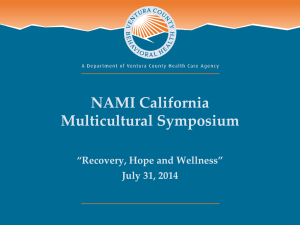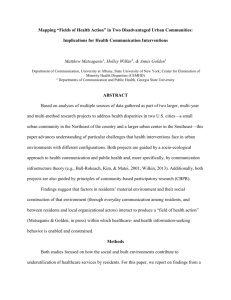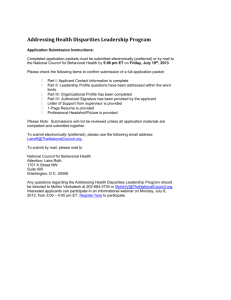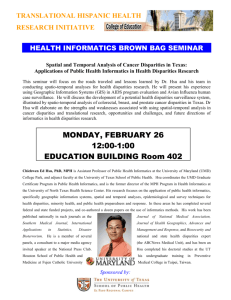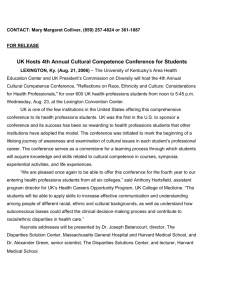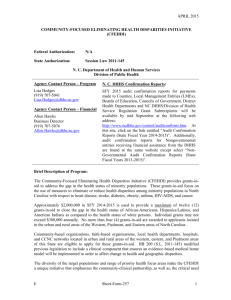here - Blog@Case
advertisement
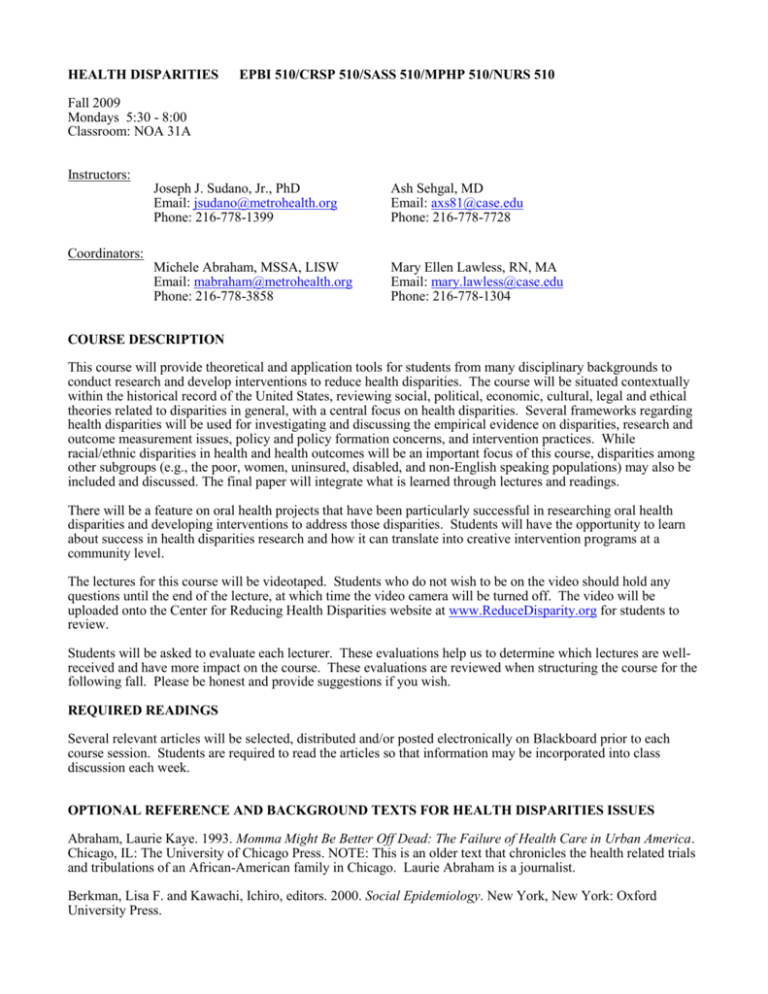
HEALTH DISPARITIES EPBI 510/CRSP 510/SASS 510/MPHP 510/NURS 510 Fall 2009 Mondays 5:30 - 8:00 Classroom: NOA 31A Instructors: Joseph J. Sudano, Jr., PhD Email: jsudano@metrohealth.org Phone: 216-778-1399 Ash Sehgal, MD Email: axs81@case.edu Phone: 216-778-7728 Michele Abraham, MSSA, LISW Email: mabraham@metrohealth.org Phone: 216-778-3858 Mary Ellen Lawless, RN, MA Email: mary.lawless@case.edu Phone: 216-778-1304 Coordinators: COURSE DESCRIPTION This course will provide theoretical and application tools for students from many disciplinary backgrounds to conduct research and develop interventions to reduce health disparities. The course will be situated contextually within the historical record of the United States, reviewing social, political, economic, cultural, legal and ethical theories related to disparities in general, with a central focus on health disparities. Several frameworks regarding health disparities will be used for investigating and discussing the empirical evidence on disparities, research and outcome measurement issues, policy and policy formation concerns, and intervention practices. While racial/ethnic disparities in health and health outcomes will be an important focus of this course, disparities among other subgroups (e.g., the poor, women, uninsured, disabled, and non-English speaking populations) may also be included and discussed. The final paper will integrate what is learned through lectures and readings. There will be a feature on oral health projects that have been particularly successful in researching oral health disparities and developing interventions to address those disparities. Students will have the opportunity to learn about success in health disparities research and how it can translate into creative intervention programs at a community level. The lectures for this course will be videotaped. Students who do not wish to be on the video should hold any questions until the end of the lecture, at which time the video camera will be turned off. The video will be uploaded onto the Center for Reducing Health Disparities website at www.ReduceDisparity.org for students to review. Students will be asked to evaluate each lecturer. These evaluations help us to determine which lectures are wellreceived and have more impact on the course. These evaluations are reviewed when structuring the course for the following fall. Please be honest and provide suggestions if you wish. REQUIRED READINGS Several relevant articles will be selected, distributed and/or posted electronically on Blackboard prior to each course session. Students are required to read the articles so that information may be incorporated into class discussion each week. OPTIONAL REFERENCE AND BACKGROUND TEXTS FOR HEALTH DISPARITIES ISSUES Abraham, Laurie Kaye. 1993. Momma Might Be Better Off Dead: The Failure of Health Care in Urban America. Chicago, IL: The University of Chicago Press. NOTE: This is an older text that chronicles the health related trials and tribulations of an African-American family in Chicago. Laurie Abraham is a journalist. Berkman, Lisa F. and Kawachi, Ichiro, editors. 2000. Social Epidemiology. New York, New York: Oxford University Press. Grembowski D. Practice of Health Program Evaluation. Thousand Oaks, CA: Sage Publications, 2001. Unequal Treatment : Confronting Racial and Ethnic Disparities in Health Care. 2003. (Committee on Understanding and Eliminating Racial and Ethnic Disparities in Health Care, Board on Health Sciences Policy, Institute of Medicine). Smedley, Brian D., Adrienne Y. Stith, and Alan R. Nelson, editors. Washington, D.C: The National Academies Press. NOTE: this text can also be purchased online from The National Academies Press at www.nap.edu Williams, Richard Allen, editor. 2007. Eliminating Healthcare Disparities in America: Beyond the IOM Report. Humana Press, Inc.: Totowa, NJ. Shi, Leiyu and Stevens, Gregory D. 2005. Vulnerable Populations in the United States. Jossey-Bass: San Francisco, CA. LaVeist, Thomas A., editor. 2002. Race, Ethnicity, and Health: A Public Health Reader, 1st edition. Jossey-Bass: San Francisco, CA. Schulz, Amy J., and Mullings, Leith, editors. 2006. Gender, Race, Class, and Health: Intersectional Approaches. Jossey-Bass: San Francisco, CA. COURSE REQUIREMENTS Students will be required to complete a project that will be handed in on November 16. Project benchmarks are listed below and completion of these benchmarks count toward your grade. Assignments must be handed in on time and must follow the guidelines below. Students should choose one of the following projects: 1. Literature Review Students should choose a topic in health disparities that is of their interest. The minimum acceptable number of relevant articles for review will be 25 for those choosing an in-depth literature review. In addition, a literature review table will be required as an appendix to your paper. Your literature review should include the following: a. Clearly stated objectives b. Description of how you located your information c. Critique of the information you found d. Synthesis of what is known about your topic and what needs to be done next (interventions, further research, etc.) 2. Research Protocol Students who desire to complete a research project proposal must use the PHS 398 Grant Application Format (see http://grants1.nih.gov/ grants/funding/ phs398/phs398.html ) and then select “Application Guide SF424(R&R)” in the Word or PDF format; specifically focus on Section 5.5 “Research Plan Component subsections 2.2-2.5 and 2.8-2.11 for details) to provide a framework for an outline and also for our evaluation of your project proposal. As you will see, this format includes the following: specific aims, background and significance, preliminary studies, research design and methods, and human subjects concerns. Don’t be confused regarding the use of PHS (Public Health Service) 398 nomenclature and the new SF424 wording…old paper form and new electronic format that includes the paper format style of proposal component assembly. 3. Organizational Experience The student is required to spend a minimum of 10 hours with a community organization or government agency that is trying to understand or address health disparities. Students can work with an organization of their choosing; however, only one student from the class will be able to work with each community organization. Students should let one of the instructors know which organization they are choosing no later than September 21. This way, the instructors can help duplicates find reasonable alternatives before the initial assignment is due on September 28. It is the student’s responsibility to contact the organization to make arrangements. In your paper, you should include a comprehensive review of relevant literature followed by details on the organization's structure, mission, vision, and main activities that address your topic. You should be able to highlight how the organization’s mission and activities relates to understanding and addressing a health disparities issue. Conclude with a critique of how well the organization is doing at understanding and addressing health disparities. If the organization does not address health disparities directly, please examine how you would consider addressing health disparities in that organization. We recommend that you give a copy of the paper to the organization or agency. Paper Benchmarks and Guidelines Due Assignment 9/28/09 Identify what type of project you are doing and describe your topic 10/26/09 Submit project outline and references 11/16/09 Final paper due at 5:30 Final Paper (60% of grade) Students who email the paper after the 5:30 deadline will be considered late. There is no penalty for handing in papers early. Papers must be sent via email to mabraham@metrohealth.org or mep2@case.edu . The final paper must be 10-15 double-spaced pages (excluding tables, figures, graphics, references, etc.) using Times New Roman 12 point font. There should be an extra line between paragraphs and one-inch margins around. The paper may include tables and figures, however, please note that tables and figures will not count toward the page limit. Tables and figures must be placed as an appendix to your paper. Please proof-read your paper. Grammar and spelling are considerations in terms of the quality of your work and are considered in your grade. The minimum number of references for an organizational experience or a research protocol is 15, for a literature review the minimum is 25. Your paper should have headers that include your name and page numbers in the upper right hand of each page. There should be a title page with the title of the paper, student name, course number, and date. OTHER COURSE REQUIREMENTS Presentation (10% grade) All students will prepare and present their paper to the class during the final 2 days of the course. The length of time for this presentation will be determined after the class roster is finalized. Because of the number of students in the course, students will be asked to adhere to a strict time limit. Presentations going over that time limit will have point deductions. Power Point and other media may be used. Students should present the following: 1. Topic description (and organization description, if appropriate) 2. Results of literature search (cite literature where appropriate) 3. Critique 4. Suggestions Participation (10% of grade) Students will be graded on their participation in class. Attendance (20% of grade) Students are required to sign in at the beginning of each class. Students will receive 1 point deduction per session missed. Excused absences will be considered on a case-by-case basis. Grading Grades are based on a 100 point scale. A=90-100 B=80-89.9 C=70-79.9 D=<70.

